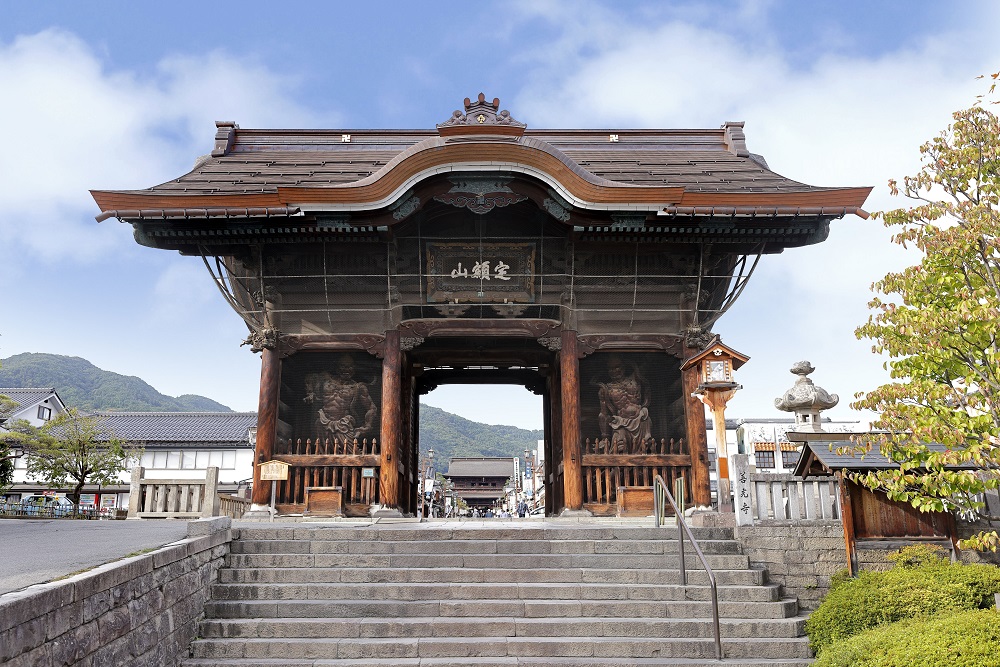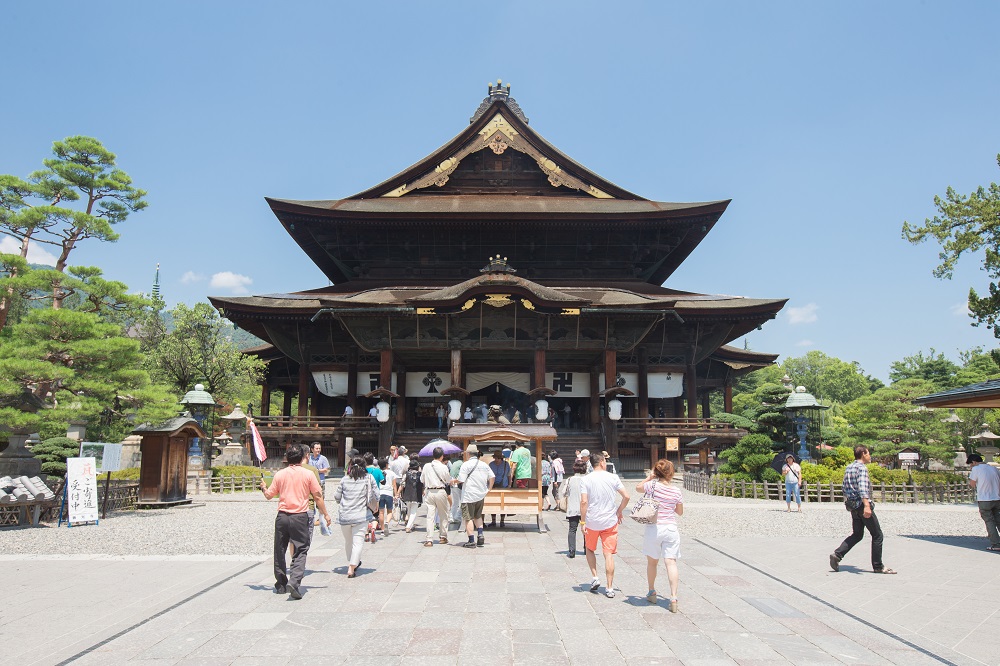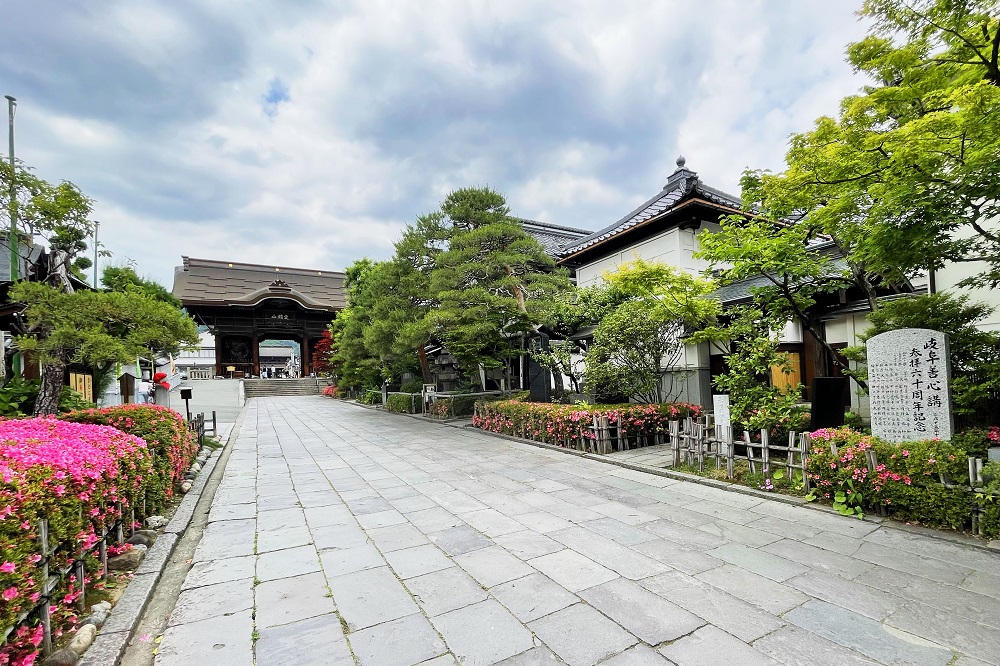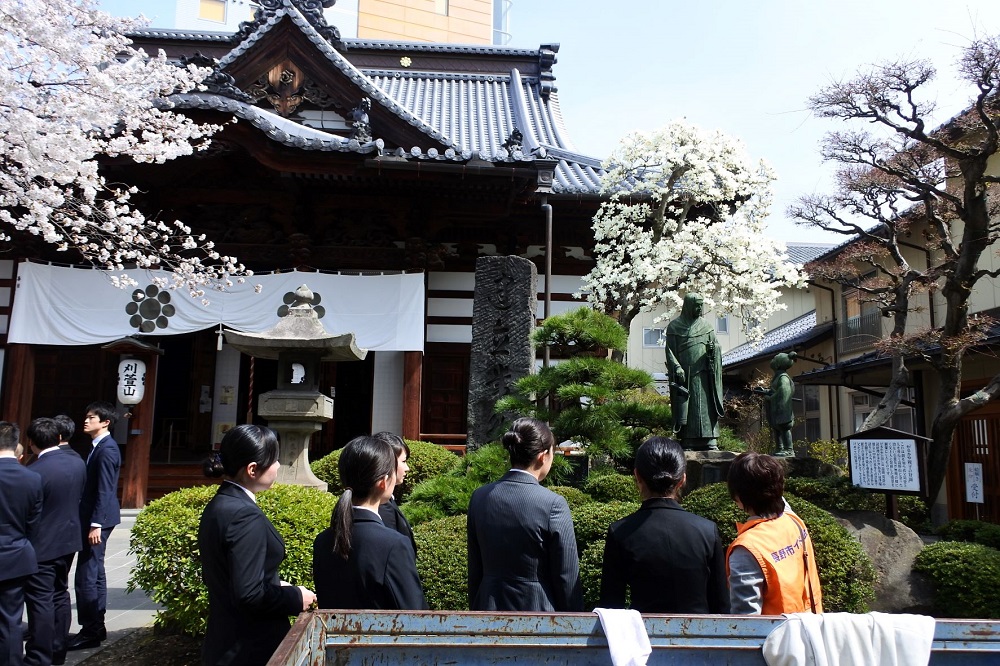Since the foundation 1,400 years ago, Zenkoji Temple has been endeared as a temple not affiliated with any religious sect and has welcomed persons of all faiths. The main image "Ikko-Sanson Amida Nyorai" [Amida Triad Sharing One Halo] is said to be the oldest Buddhist image in Japan and was introduced into Japan with Buddhism via Baekje [Paekche] in Korean Peninsula in 552, but the main image is completely unrevealed since 654. Join palms together and feel the sense of awe when praying to the kami [deity].

©善光寺
When visiting the Zenkoji Temple, the first to come in site will be the Nio-mon Gate. Originally built in 1752, and destroyed twice by fire, the gate was rebuilt in 1918. The gate is approximately 13 meters wide, 7 meters long and 14 meters high, housing statues of Nio, Sanbokojin and Three-faced Daikokuten. These statues are joint works of modern sculpting masters Takamura Koun and Yonehara Unkai. The beautifully proportioned stances and menacing expressions of the Nio statues are a must see. The Nio statues are positioned at the entrance of the temple in a pair - one with its mouth open and the other with its mouth closed. This is believed to prevent the intrusion of Buddhist enemies. Generally, the open-mouthed statue is placed to the left and the close-mouthed statue is placed to the right, but at Zenkoji, the statues are reversely placed. The Three-faced Daikokuten [combined image of Bishamonten, Benzaiten and Daikokuten], positioned behind the Nio statue, is worshiped as the deity of fertility, prosperity and family safety.

©善光寺
The main hall of the Zenkoji Temple was destroyed several times by fire, and the main hall today rebuilt in 1707 is designated as a National Treasure as a structure manifesting Buddhist architecture of the mid-Edo Era. Viewed from above, the main hall is characterized by its significant depth and T-shaped structure. The interior is divided into an outer sanctuary, an inner sanctuary, and an innermost sanctuary, with the entrance representing the daily world and the innermost sanctuary representing paradise. The outer sanctuary is dedicated to Enma Daio [ruler of hell], a frightening and demonic entity is said to pass judgment on whether a person is good or evil after death. The inner sanctuary is dedicated to Mirokubosatsu and Jizobosatsu, said to bring salvation, and the innermost sanctum [Ruridan] is dedicated to principal deity of Zenkoji. Ikko-Sanson Amida Nyorai - the three images of Budda, is said to be one of the oldest Buddhist statues in Japan, brought to Japan when Buddhism was first introduced to the country. The original statue itself is kept in strict secrecy, however "Maedachi Honzon" [a replica of the hidden statue of the principal image housed in the temple] is displayed once every year during "Gokaicho" [a ceremony allowing the public a rare opportunity for viewing].

©善光寺
The long path made of stone leading to the main hall from Nio-mon Gate is said to be comprised with 7,777 stones, and restaurants and stores are lined up for souvenirs from Nagano and much more.
From JR Nagano Station: Take the bus departing from Boarding Spot No. 1 (bound for Zenkoji) at the Zenkoji Exit Bus Rotary for 15 minutes and disembark at Zenkoji Daimon Bus Stop
5-minute walk from the Zenkoji Daimon Bus Stop to the main hall of the Zenkoji Temple
Take a part in a tour of visiting the Buddhist alter, which passes underneath the Ruridan [innermost sanctum] of the main hall. This "Okaidan Tour" is a groping walk through a pitch-black corridor passing directly under the Gohonzon [principal image] of the temple. At the back of the innermost sanctuary, the staircase leads to the entrance of the corridor, and at the bottom of the stairs walk slowly through a dark corridor for approximately 45 meters in length. If you touch the wall on the right side of the corridor with your hand, you will be able to touch the lock directly under the statue of the principal image, forming a connection with the deity, and entry into "Gokuraku Jodo" [Paradise] will be promised.

©善光寺
"Shukubo" are accommodation facilities operated by temples and shrines throughout Japan. It used to be a facility for monks and worshipers, and has recently opened to general tourists as well. At Zenkoji Temple, there are a total of 39 Shukubo of Tendai-shu temples and Jodo-shu temples. The guided tours by Shukubo will be guided by monks or an authorized guide assigned to the Shukubo to "Oasaji" [a Buddhist morning service held at sunrise], held 365 days a year, as well as to the temple precinct and other historical sites. Another part to enjoy the stay at Shukubo is the "Shōjin Ryōri" [Buddhist Vegetarian Cuisine], made only with seasonal vegetables, beans, and grains. Each Shukubo serves original cuisine.

©善光寺
To find out more about the Zenkoji Temple and Nio-mon Gate, a walking tour with a volunteer guide from the Nagano City Guide Association is recommended. [Reservation is Required] Some courses start from Nagano Station, and English-speaking guides are occasionally available.

To experience Zenkoji Temple to the fullest, we recommend staying at a Shukubo [accommodation facility]. Enjoy the unique "Shōjin Ryōri" [Buddhist vegetarian cuisine] and other Shukubo-exclusive dishes. Stay overnight or simply just have a meal - the choice is yours. Rengein and other Shukubo welcomes guests from overseas.